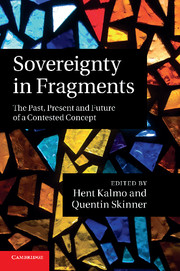Book contents
- Frontmatter
- Contents
- Notes on contributors
- Acknowledgements
- Introduction: a concept in fragments
- 1 The sovereign state: a genealogy
- 2 The apparition of sovereignty
- 3 The Westphalian myth and the idea of external sovereignty
- 4 Double binds: sovereignty and the just war tradition
- 5 The durability of organized hypocrisy
- 6 A matter of fact? The many faces of sovereignty
- 7 The survival of sovereignty
- 8 Sovereignty and after
- 9 Prolegomena to the post-sovereign Rechtsstaat
- 10 Sovereignty beyond the state
- 11 Sovereignty between government, exception and governance
- 12 Conclusion: vocabularies of sovereignty – powers of a paradox
- Bibliography
- Index
2 - The apparition of sovereignty
Published online by Cambridge University Press: 04 February 2011
- Frontmatter
- Contents
- Notes on contributors
- Acknowledgements
- Introduction: a concept in fragments
- 1 The sovereign state: a genealogy
- 2 The apparition of sovereignty
- 3 The Westphalian myth and the idea of external sovereignty
- 4 Double binds: sovereignty and the just war tradition
- 5 The durability of organized hypocrisy
- 6 A matter of fact? The many faces of sovereignty
- 7 The survival of sovereignty
- 8 Sovereignty and after
- 9 Prolegomena to the post-sovereign Rechtsstaat
- 10 Sovereignty beyond the state
- 11 Sovereignty between government, exception and governance
- 12 Conclusion: vocabularies of sovereignty – powers of a paradox
- Bibliography
- Index
Summary
The concept of sovereignty is generally approached in a twofold fashion. First, one seeks to understand its meaning. Second, one aims to derive some consequences from the fact that a certain community, or institution, can be said to be sovereign. As for the meaning of sovereignty, an analytical approach has often prevailed in the recent past over what we may call a metaphysical one. The metaphysical approach sought to identify the essence of sovereignty. The analytical approach has attempted to establish that such an approach had major inherent drawbacks and failed to account for all the uses of the term ‘sovereign’. The analytical approach did not seek to identify an essence of sovereignty. Instead, it purported to explore all the possible uses of the term in positive law. As a result, this analytical approach has been in a position to show that in many cases a full and unified set of consequences, especially of legal ones, did not stem from the use of the term. Different meanings involved different legal consequences.
In this chapter, I wish to suggest that the study of sovereignty could benefit from another approach, which would focus on the way in which sovereignty has appeared, or rather has been said to appear, in modern political consciousness. It is suggested here that some key characteristics of the legal concept of sovereignty will be left in the dark if they are not envisaged in this fashion.
- Type
- Chapter
- Information
- Sovereignty in FragmentsThe Past, Present and Future of a Contested Concept, pp. 47 - 63Publisher: Cambridge University PressPrint publication year: 2010
- 5
- Cited by



